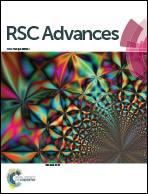Enhanced electrochemical performance of morphology-controlled titania-reduced graphene oxide nanostructures fabricated via a combined anodization-hydrothermal process†
Abstract
Titania nanotubes (TNTs) synthesized by an anodization process were used as a basic substrate material to create different morphologies of quasi-1D (nanoribbons), 2D (nanoflakes), and 3D (nanoparticles) structures via an alkali-controlled hydrothermal route. Graphite oxide was introduced to the hydrothermal unit to fabricate graphene oxide/reduced graphene oxide–titania nanostructure hybrid materials. The presence of NaOH and graphene oxide in the hydrothermal environment had a profound effect on the surface morphology of the nanostructures. NaOH acted as both an etchant to convert TNT surfaces into low-dimensional structures and as a reducing agent to convert graphene oxide into reduced graphene oxide. Graphene oxide inhibited the etching rate to tune the surface morphologies into 1D, 2D, and 3D nanostructures. The electrochemical supercapacitance of all the nanostructures was characterized. Among the prepared samples, the nanostructured hybrid sample of reduced graphene oxide, titania nanoflakes, and TNT exhibited enhanced electrochemical performance with quite high specific capacitance. This superior electrochemical performance is attributed to the specific nanostructure, which provides short pathways for fast transport of salt ions and improved specific surface area for more adsorption sites for the formation of an electrical double layer, which leads to fast charge transfer.


 Please wait while we load your content...
Please wait while we load your content...